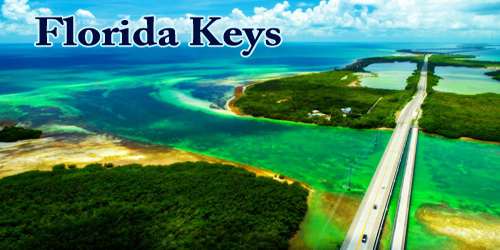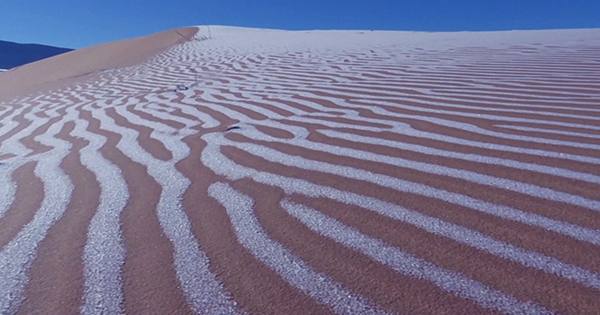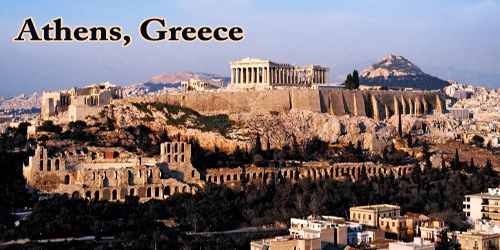The Florida Keys are home to the only coral reef in the United States, and it is located off the southern coast of Florida forming the southernmost part of the continental United States. They begin at the southeastern coast of the Florida peninsula, about 15 miles (24 km) south of Miami, and extend in a gentle arc south-southwest and then westward to Key West, the westernmost of the inhabited islands, and on to the uninhabited Dry Tortugas. The islands lie along the Florida Straits, dividing the Atlantic Ocean to the east from the Gulf of Mexico to the northwest, and defining one edge of Florida Bay. At the nearest point, the southern part of Key West is just 90 miles (140 km) from Cuba. The Florida Keys are between about 24.3 and 25.5 degrees North latitude. The Florida Keys offer a fun tropical fix, fantastic fishing, and a few pretty palm-lined stretches of sand.
Trailing south of Miami for more than 110 miles to within about 90 miles of Cuba, the Keys are coral islands linked by causeways, so visitors can drive between them on the Overseas Highway, which runs from Key Largo south to Key West.

More than 95 percent of the land area lies in Monroe County, but a small portion extends northeast into Miami-Dade County, such as Totten Key. The total land area is 137.3 square miles (356 km2). As of the 2010 census the population was 73,090 with an average density of 532.34 per square mile (205.54/km2), although much of the population is concentrated in a few areas of much higher density, such as the city of Key West, which has 32% of the entire population of the Keys. The US Census population estimate for 2014 is 77,136.
The city of Key West is the county seat of Monroe County. The county consists of a section on the mainland which is almost entirely in Everglades National Park, and the Keys islands from Key Largo to the Dry Tortugas.
Top attractions include the John Pennekamp Coral Reef State Park and the Florida Keys National Marine Sanctuary off Key Largo, with great diving and snorkeling; Bahia Honda State Park, where you’ll find some of the prettiest beaches; and the legendary Key West, where an anything-goes mentality complements the colorful Caribbean-style cottages and rich Hemingway history.
The keys were originally inhabited by such Native American peoples as the Calusa and Tequesta. The Spanish explorer Juan Ponce de León visited the area in 1513. De León named the islands Los Martires (“The Martyrs”), as they looked like suffering men from a distance. “Key” is derived from the Spanish word cayo, meaning small island. The first permanent settlers arrived about 1822 and engaged in fishing and salvaging shipwrecks. Population growth and economic development in the archipelago have fluctuated over time, reaching one of the highest peaks in the 1890s. The greatest disaster to strike the keys was a hurricane in September 1935 that killed hundreds of people and caused widespread property damage.
The Keys were long accessible only by water. This changed with the completion of Henry Flagler’s Overseas Railway in the early 1910s. Flagler, a major developer of Florida’s Atlantic coast, extended his Florida East Coast Railway down to Key West with an ambitious series of oversea railroad trestles. Three hurricanes disrupted the project in 1906, 1909, and 1910.
The western terminus of the Florida Keys is sometimes considered to be Key West, the most populous and economically developed of the islands. The Overseas Highway, running from the mainland to Key West, connects all of the main islands and is one of the longest overwater roads in the world, with 42 bridges, including one 7-mile (11-km) span. Completed in 1938, the highway was built over the route of the Florida East Coast Railway, finished in 1912 by financier and developer Henry M. Flagler and destroyed by the 1935 hurricane.
Largest of the keys is Key Largo, about 30 miles (50 km) long and formerly known for its plantations of key limes (used to make key lime pies). John Pennekamp Coral Reef State Park, which contains large living coral formations, is the first undersea park in the United States. It is some 25 miles (40 km) long and 3 miles (5 km) wide and lies along Key Largo’s east coast. Islamorada, located mainly on Upper Matecumbe Key, has a monument to World War I veterans and victims of the 1935 hurricane. Long Key State Park is on Long Key, just southwest of Islamorada. The main town of the middle keys is Marathon, a centre of extensive resort development. Nearby is the Museum of Natural History of the Florida Keys and a dolphin research centre. Bahia Honda State Park, on Bahia Honda Key, features a large area of tropical palms and beach recreation facilities.
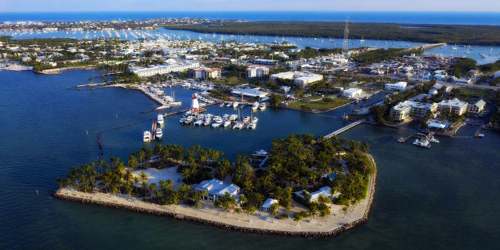
One of the longest bridges when it was built, the Seven Mile Bridge connects Knight’s Key (part of the city of Marathon in the Middle Keys) to Little Duck Key in the Lower Keys. The piling-supported concrete bridge is 35,862 ft (10,931 m) or 6.79 miles (10.93 km) long. The current bridge bypasses Pigeon Key, a small island that housed workers building Henry Flagler’s Florida East Coast Railway in the 1900s, that the original Seven Mile Bridge crossed. A 2.2-mile (3.5 km) section of the old bridge remains for access to the island, although it was closed to vehicular traffic on March 4, 2008. The aging structure has been deemed unsafe by the Florida Department of Transportation. Costly repairs, estimated to be as much as $34 million, were expected to begin in July 2008. Monroe County was unable to secure a $17 million loan through the state infrastructure bank, delaying work for at least a year. On 14th June 2008, the old bridge section leading to Pigeon Key was closed to fishing as well. While still open to pedestrians walking, biking and jogging if the bridge were closed altogether, only a ferry subsidized by FDOT and managed by the county would transport visitors to the island.
Islamorada proclaims itself the “sport fishing capital of the world,” with tarpon, bonefish, and permit to catch; and Marathon is also excellent for casting a line. Big-name fishing tournaments are held in the surrounding waters each year. This village of homey islands includes Windley Key, Upper Matecumbe Key, and Lower Matecumbe Key. Islamorada is heralded for its angling diversity and features the Keys’ largest fleet of offshore charter and shallow-water “backcountry” boats with tournament-grade captains. South of Islamorada, walk-through undeveloped tropical forests at Long Key State Park. Further down the road on Grassy Key, the Dolphin Research Center affords a rare opportunity for one-on-one contact with these intelligent mammals.
Many of the keys fall within the boundaries of three national parks. Biscayne National Park, a short distance south of Miami Beach, includes several of the northernmost keys, and most of the keys in Florida Bay are within Everglades National Park. Dry Tortugas National Park, which includes historic Fort Jefferson (begun 1846), encompasses all the westernmost keys. The keys are protected by the Florida Keys National Marine Sanctuary, established in 1990, which covers an area of some 3,600 square miles (9,300 square km). Much of the northern area of the lower keys has been designated the Great White Heron National Wildlife Refuge, and another refuge is located immediately west of Key West. Big Pine Key, largest of the lower keys, is a refuge for the tiny key deer and has unusual displays of cacti.
The climate of the Florida Keys is tropical savanna (Köppen climate classification: Aw). Other than some areas of coastal Miami, the Florida Keys are the only areas in the continental United States to never report freezing temperatures since settlement. The record low in Key West is 41 °F (5 °C) (in both 1886 and 1981), and low temperatures below 48 °F (8.9 °C) are rare. Most of the Florida Keys fall into USDA zone 11a to 11b.
There are two main “seasons” in the Florida Keys, a hot and wet season from June through October, and a dry season from November though April, that features little rainfall, sunny skies, and warm breezy conditions. The warm and sunny winter climate, with average highs in the middle 70’s °F (24 °C) and lows above 60 °F (15 °C), is the main tourist season in the Florida Keys. Key West is the driest city in Florida, and most of the Florida Keys can become quite dry at the height of the dry season. Some of the more exposed vegetation in the keys is scrub, stunted due to the intense sun, quick draining sandy soil, and arid winter climate.
At the mid-point of the Florida Keys, Marathon includes Boot, Knights, Hog, Vaca, Stirrup, Crawl and Little Crawl keys, East and West Sister’s Island, Deer and Fat Deer keys, Long Pine and Grassy keys. It incorporated as the City of Marathon in 1999, and has fast become the family-friendly destination of the Florida Keys, filled with activities for everyone such as golf, world-class diving and snorkeling, boating, opportunities to swim with dolphins, stroll the white sand of Sombrero Beach and enjoy an abundance of water sports like kayaking and standup paddling.
The Keys are occasionally threatened by tropical storms and hurricanes, leading to evacuations to the mainland. Hurricane Georges, after destroying much of the housing and infrastructure on many of the Caribbean islands, caused damage and extensive flooding in the Lower Keys in 1998, before making landfall in Mississippi. In 2005, Hurricanes Katrina, Rita, and Wilma affected the Keys (although none made a direct hit), causing widespread damage and flooding. The most severe hurricane to hit the area was the Labor Day Hurricane of 1935, a Category 5 hurricane.
On September 10, 2017, Hurricane Irma made landfall in Cudjoe Key. The storm destroyed an estimated 25% of the houses on the Keys and another 65% suffered major damage. Most residents had evacuated before the storm hit the area. On September 12, parts of the Keys were still inaccessible by cause way and some areas were closed to the public. Governor Rick Scott reported devastation; most areas were without power or water. The damage was the worst in the Lower Keys, though less severe in Key West; parts of the Lower Keys may be uninhabitable for months.
Key West is the nation’s southernmost city and is actually closer to Havana, Cuba than Miami. Stroll amid tiny, colorfully-restored homes where thousands of cigar workers lived in the 19th century. Huge, architecturally rich mansions were built by business tycoons and city leaders. Some have been converted into guest houses and inns with modern swimming pools and lush tropical gardens. Treasure hunter Mel Fisher also called Key West home. Using Key West as a base, he recovered millions of dollars worth of gold and silver from the ship Nuestra Señora de Atocha, a 17th-century Spanish galleon that sank 45 miles west of Key West. Years before he died, Fisher had the good sense to establish the Mel Fisher Maritime Heritage Society Museum, where visitors can view and even touch some of the riches of the Atocha and the Santa Margarita.
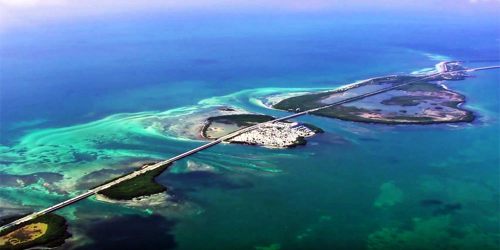
The major industries are fishing and tourism, including ecotourism, with many visitors scuba diving in the area’s protected waters. A ferry now takes riders between Key West and Fort Myers, as well as Marco Island due north on the mainland, along the western edge of Florida Bay.
The Florida Keys are home to a wide variety of plant and animal life. Mangroves, sea-grasses, and coral reefs are abundant. Animals such as alligators, sea turtles, and the endangered manatee can be found there, and more than 600 species of fish live in the reefs. The keys are a popular tourist destination, and tourism and commercial fishing are the major components of the economy.
Information Sources:
